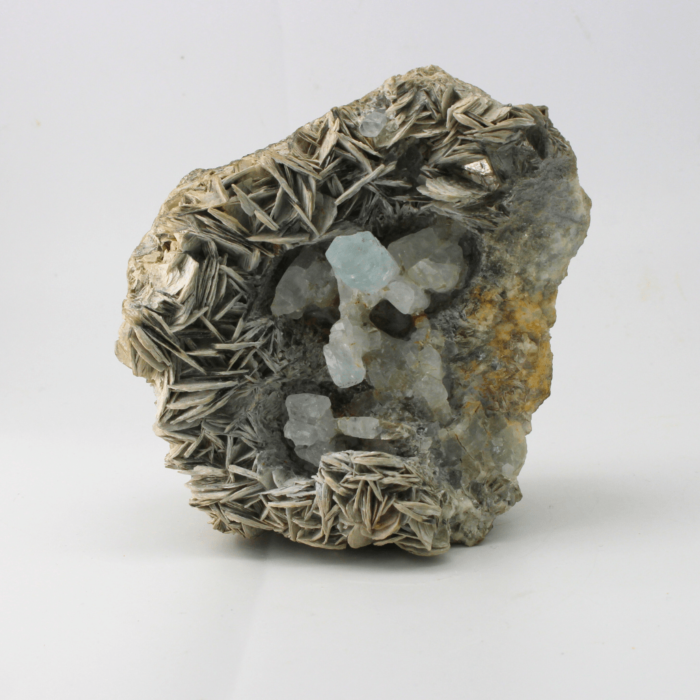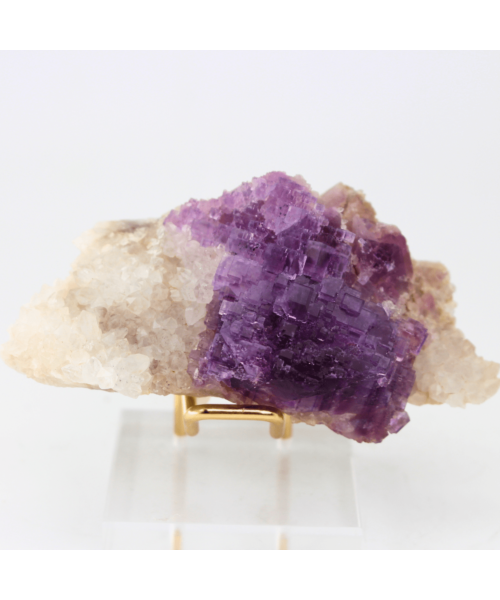Aquamarine Naturally Terminated Himalayas 698g
Aquamarine Naturally Terminated Himalayas 698g
Mineral Name: Aquamarine Chemical Formula: Be3Al2(SiO3)6 - Beryllium Aluminum Silicate Color: Aquamarine is best known for its captivating blue to blue-green hues, reminiscent of the clear waters of the sea. The color is caused by trace amounts of iron impurities within the crystal lattice. Crystal System: Hexagonal Hardness: 7.5 - 8 on the Mohs scale Luster: Vitreous Transparency: Transparent to translucent Specific Gravity: 2.68 - 2.74 Cleavage: Indistinct Fracture: Conchoidal Streak: White Occurrences: Aquamarine is commonly found in granite pegmatites, as well as in metamorphic rocks. It often occurs alongside other minerals such as quartz, feldspar, and mica. Significant deposits have been discovered in Brazil, Madagascar, Afghanistan, Russia, and the United States. Notable Localities: Noteworthy occurrences of aquamarine include the Mursinka mine in Russia, the Shigar Valley in Pakistan, the Santa Maria de Itabira mine in Brazil, and the Mount Antero and Mount White mines in Colorado, USA. Formation: Aquamarine forms in pegmatites and hydrothermal veins, where beryllium-rich solutions interact with aluminum and silica-rich minerals. The presence of trace elements, especially iron, imparts the characteristic blue and blue-green colors to the crystal. The hexagonal crystal structure contributes to the development of well-formed, elongated prismatic crystals. Unique Features: Aquamarine is prized for its stunning color, which can range from delicate sky blue to deep blue-green. The crystals often grow in large, well-formed hexagonal prisms with flat terminations. Gem-quality aquamarine is highly sought after for use in jewelry, while larger, transparent crystals are also valued by mineral collectors. Uses: Aquamarine is primarily used as a gemstone in jewelry, including rings, earrings, and necklaces. Its pleasing color and excellent transparency make it a popular choice for various types of jewelry settings. In addition to its aesthetic appeal, aquamarine is believed by some to possess metaphysical properties, including promoting calmness and communication. Caution: While aquamarine is generally safe for use in jewelry, it is important to be aware that some specimens may undergo color treatment. Heat treatment is commonly applied to enhance or alter the color of aquamarine, and this information should be disclosed by reputable gemstone dealers.| Weight (Grams) | 698.000000 |
|---|---|
| Manufacturer | Imperial Time |
| Length (Depth) | 102cm |
| Width | 64mm |
| Height (mm) | 100mm |
| Main Stone | No Stone |
| Main Stone Creation | Natural |
| Total Carat Weight | 139ct |
| Number of Diamonds | 0 |
| Number of Gemstones | 1 |
| Gemstone | No Stone |
| Certification | Imperial Time UK Ltd |
| Year | 2024 |
| Seller Waranty | 12-month |
We aim to deliver within 1-3 working days, Monday to Saturday, once payment has been received.
Free Click & Collect on all orders We offer free click & collect across the UK (excludes Ireland and the Channel Islands). Delivery times may vary depending on the product you select. You will be provided with an estimated delivery date once your order is confirmed. In general, your order will be delivered within 3-6 working days from being dispatched. We will email you when your order has been processed and again when your order has been dispatched. For more details, Contact with us.
Returns, Refund and Cancellation Policy
We operate a returns policy for unwanted and faulty goods. Should you need to return any item to us for any reason please contact us first by telephone or e-mail - see our Contact page.
Unwanted Goods
Please return goods unused and in original packaging in perfect condition for resale within (14) days of receipt. We recommend obtaining proof of postage. A full refund (minus the shipping costs) will be made on receipt of the returned goods.
Please note that you are responsible for shipping costs when returning unwanted goods.
What our customers are saying
Do you Have any Questions?
I would like to buy this item. How do I proceed?
To purchase this item:
- Click on ‘Add to Cart’ and then, ‘Proceed to Payment’.
- Enter your billing details and click on ‘Continue’.
- Enter your card details and click on ‘Pay for order’.
- We will ship your order after your payment is confirmed.
How is my order secure?
All our items are appropriately packaged and sent using Royal Mail Special Delivery insured, to ensure they don’t get damaged during transit.
When will I receive my order?
- Free Next Day Delivery On Selected Items – Order by 11 AM for delivery the following day, Monday –Friday.
- Free Standard Delivery – We aim to deliver any order outside the UK within 2-3 working days.
What payment method can I use?
We accept the following payment methods:
- Debit Card/ Credit Card (for both watches and jewellery)
- Cash upon collection.














Please complete your information below to login.
Sign In
Create New Account